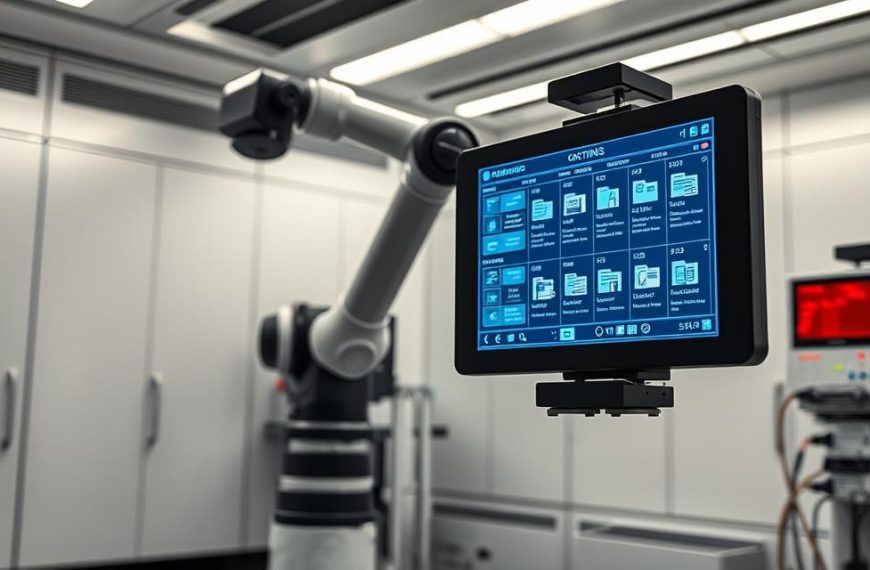The rise of AI-generated content has transformed the writing landscape, making it increasingly challenging to distinguish between human-written and machine-generated text.
To address this issue, Grammarly has developed an innovative AI detection tool that helps ensure the authenticity and integrity of written communications.
This comprehensive guide will explore the key features of Grammarly’s AI Checker and provide step-by-step instructions on how to use it effectively in various contexts, including academic writing and content creation.
By leveraging this cutting-edge technology, students, professionals, and content creators can maintain the highest standards of writing integrity and avoid plagiarism.
Understanding Grammarly AI Checker
Understanding the capabilities of Grammarly AI Checker is crucial in today’s digital landscape where AI-generated content is becoming increasingly prevalent.
Grammarly AI Checker is an advanced tool designed to identify content created by artificial intelligence systems such as ChatGPT, Google Gemini, and Claude. The detection system works by analyzing writing patterns, structures, and characteristics that are typically associated with AI-generated text rather than human writing.
- Grammarly AI Checker provides a percentage-based analysis that indicates how much of a given text appears to have been created using AI tools.
- The technology behind Grammarly AI Checker relies on sophisticated machine learning models trained on extensive datasets containing both human-written and AI-generated content, aiding in plagiarism detection.
- Understanding this checker is essential for maintaining writing integrity and adhering to academic and professional standards, particularly in regards to plagiarism.
By utilizing Grammarly AI Checker, users can ensure the authenticity of their content and make informed decisions about their writing processes.
Why AI Detection Matters in Today’s Writing Landscape
As AI writing tools proliferate, the need to distinguish between human and AI-generated content grows. The increasing reliance on AI for content creation has significant implications for integrity in writing.
AI detection matters because undisclosed use of AI-generated content may constitute a form of plagiarism. In academic and professional settings, maintaining integrity is crucial. Detection tools provide necessary transparency, enabling readers to evaluate the authenticity and reliability of the information they consume.
The ability to identify AI-written content helps preserve the value of human creativity and original expression in writing. For content creators, AI detection tools offer feedback that can help them develop more authentic, engaging content.
As noted by experts, “When you use generative AI to write, summarise, or paraphrase, you need to include a citation.” This practice ensures transparency and maintains the integrity of the work.
Key Features of Grammarly AI Checker
With its cutting-edge technology, Grammarly AI Checker provides users with a comprehensive writing assistance solution. This tool is designed to work seamlessly with other Grammarly features, creating a robust ecosystem for writers.
AI-Generated Content Detection
The AI Checker is equipped with advanced algorithms to detect AI-generated content. This feature is crucial in maintaining the authenticity of written work. By identifying AI-generated text, users can ensure that their content is original and not inadvertently plagiarised.
Percentage-Based Analysis System
Grammarly’s AI Checker utilises a percentage-based analysis system to provide users with a clear understanding of how much of their content is likely to be AI-generated. This nuanced approach allows for a more accurate assessment of content authenticity.
Integration with Other Grammarly Tools
The AI Checker integrates smoothly with Grammarly’s suite of writing tools, including the Grammar Checker, Plagiarism Checker, and Citation Generator. This integration enables users to streamline their writing process, ensuring that their work is both original and well-crafted.
| Feature | Description | Benefit |
|---|---|---|
| AI-Generated Content Detection | Identifies content generated by AI | Ensures authenticity |
| Percentage-Based Analysis | Provides a percentage likelihood of AI generation | Offers nuanced insight |
| Integration with Grammarly Tools | Works alongside other Grammarly features | Streamlines the writing process |
In conclusion, Grammarly AI Checker is a powerful tool that enhances the writing experience by providing a comprehensive solution for content authenticity and quality. By leveraging its advanced features, users can ensure that their work is original, well-crafted, and free from AI-generated content.
How Grammarly AI Checker Works
Understanding how Grammarly’s AI detection works is crucial in today’s writing landscape. The Grammarly AI Checker is a sophisticated tool that differentiates between human and AI-generated content.
The Technology Behind AI Detection
The technology behind Grammarly’s AI detection is based on advanced machine learning algorithms. These algorithms are trained on vast datasets containing examples of both human-written and AI-generated text, enabling the system to identify patterns that distinguish between the two.
Machine Learning Model Training
Grammarly’s machine-learning model is trained on hundreds of thousands of human and AI-generated texts. The training process involves:
- Exposing the system to diverse writing styles, topics, and formats.
- Machine learning algorithms identifying patterns that consistently differentiate between human and AI writing.
- Continuous refinement as new AI detection technologies emerge.
- Oversight by a team of computational linguists and machine learning specialists.
This comprehensive training enables Grammarly’s AI Checker to work effectively in analysing content.
Setting Up Grammarly AI Checker
To get started with Grammarly AI Checker, users need to follow a straightforward setup process. This involves a few key steps that ensure the tool is properly installed and ready for use.
System Requirements
The AI detector tool on this page is compatible with any browser, making it versatile and easy to integrate into existing workflows. Users can access Grammarly’s AI detection feature through their website or by installing the Grammarly browser extension.
Subscription Options
Grammarly offers various subscription plans to suit different needs. Users can choose from a range of options, including premium subscriptions that offer advanced features like AI detection.
Installation Process
Installing Grammarly AI Checker begins with creating a Grammarly account or logging into an existing one. Users can then install the browser extension or download the desktop application. The process typically takes less than five minutes from start to finish, after which users can start using the AI detection features.
Step-by-Step Guide to Using Grammarly AI Checker
To effectively utilise Grammarly’s AI Checker, follow this step-by-step guide. The tool is designed to help users identify AI-generated content, ensuring the authenticity of their writing.
Accessing the AI Checker Tool
The first step is to access the Grammarly AI Checker tool. This can be done by logging into your Grammarly account and navigating to the AI Checker section.
Uploading or Pasting Text
Once you have accessed the tool, you can either upload your document or paste the text directly into the interface. Grammarly’s system is designed to handle various text formats, making it easy to assess your content.
Interpreting the Results
After submitting your text, Grammarly’s AI detection model will provide a percentage indicating the likelihood that the text is AI-generated. Key points to consider when interpreting the results include:
- Understanding the percentage-based scoring system.
- Recognising that higher percentages indicate a greater likelihood of AI-generated content.
- Using section-by-section breakdowns for longer texts to identify specific areas with higher AI probability.
- Utilising color-coding to quickly identify potentially problematic sections.
- Interpreting results contextually, considering the purpose of the writing and applicable standards.
- Revising text to sound more human-written when high AI percentages are detected.
- Remembering that AI detection is probabilistic rather than definitive.
Understanding AI Detection Scores
Understanding the nuances of AI detection scores is crucial for effectively utilising tools like Grammarly AI Checker. The detection score indicates the likelihood that a piece of content was generated using AI.
What Different Percentages Mean
The percentage-based analysis system used by Grammarly AI Checker provides insight into the probability that the text was AI-generated. A higher percentage indicates a greater likelihood of AI involvement in the writing process. For instance, a score of 80% or higher suggests that the content is likely to have been generated using AI. Conversely, lower scores indicate that the content is more likely to be human-generated.
Limitations of AI Detection
While AI detectors like Grammarly’s can provide valuable insights, they are not foolproof. As noted by experts, “no AI detection system can provide 100% certainty about the origin of text.” The accuracy of these tools can vary based on factors such as text length, subject matter, and the specific AI system used. For more information on using Grammarly AI Detector for academic writing, visit Grammarly AI Detector for Academic Writing. Some of the limitations include:
- No AI detection system can guarantee 100% accuracy.
- Detection accuracy varies based on several factors, including text length and subject matter.
- Heavily edited AI-generated content may evade detection.
Grammarly Authorship: Beyond Basic AI Detection
Beyond basic AI detection, Grammarly Authorship provides an innovative approach to verifying writing authenticity. This feature is designed to offer a detailed insight into the writing process, making it easier for writers to demonstrate the originality of their work.
How Authorship Categorises Text
Grammarly Authorship categorises text by providing a comprehensive breakdown of the writing process. It differentiates between manually typed content and AI-assisted text, giving writers a clear understanding of their work’s composition.
Creating Shareable Reports
With Authorship, you receive a shareable report that can be easily shared with professors, supervisors, or editors. The report includes detailed breakdowns of content origins and a replay feature that allows viewers to see the document’s evolution from start to finish, providing an additional layer of validation for your writing process.
These reports can be customised to highlight specific aspects of the writing process, making it simple to provide evidence of original work in academic or professional contexts, thus promoting transparency and trust in the writing process.
Practical Applications of Grammarly AI Checker
The versatility of Grammarly AI Checker makes it a valuable tool for multiple industries. Professionals can polish AI-generated reports, emails, and business documents so they sound clear, confident, and professional.
Its applications span various fields, making it an indispensable asset for different users.
For Students and Academics
Students and academics can utilise Grammarly AI Checker to ensure the authenticity of their work. It helps in maintaining academic integrity by detecting AI-generated content, thus promoting original writing.
For Content Creators
Content creators can benefit from Grammarly AI Checker by ensuring their content maintains a natural tone and style. This tool is particularly useful in identifying and adjusting AI-generated content to better align with the creator’s voice.
For Businesses and Professionals
Businesses and professionals can leverage Grammarly AI Checker to enhance their writing. The tool helps in maintaining brand voice consistency, ensuring customer-facing content is appropriate, and verifying that important documents meet clarity and precision standards.
| Industry | Application | Benefit |
|---|---|---|
| Business | Maintaining brand voice consistency | Enhanced professionalism |
| Academia | Detecting AI-generated content | Promotes original writing |
| Content Creation | Adjusting AI-generated content | Better alignment with creator’s voice |
By using Grammarly AI Checker, professionals can ensure their writing is clear, confident, and professional, ultimately enhancing the quality of their work.
Humanising AI-Generated Text with Grammarly
Grammarly’s AI humanizer tool is revolutionising the way we approach content creation. By leveraging advanced AI technology, it refines AI-generated text to sound more natural and engaging.
The AI Humaniser Tool
The AI humaniser tool uses Natural Language Processing to analyze and rewrite text in a human-like way without altering its original meaning. This process enhances the overall clarity and readability of the content.
Best Practices for Natural-Sounding Content
To create natural-sounding content, it’s essential to understand the principles of engaging writing. Varying sentence structure and length helps break rhythmic patterns often found in AI-generated text. Incorporating personal anecdotes and unique perspectives adds authenticity, improving overall clarity.
AI Detection vs. Plagiarism Checking: Understanding the Difference
AI detection and plagiarism checking serve distinct purposes in evaluating content authenticity. While both are used to assess originality, they analyze text in different ways.
AI detectors estimate whether a piece of text was generated by AI by analyzing writing patterns, predictability, and structure. In contrast, plagiarism checkers compare text against existing published sources to identify copied or improperly cited content.
- AI detection and plagiarism checking are complementary approaches to ensuring content originality.
- Plagiarism checking focuses on identifying copied content, regardless of whether it was written by humans or AI.
- AI detection tools identify machine-generated text, regardless of whether it’s original or plagiarised.
Understanding this distinction helps users select the appropriate tool for their needs. Using both AI detection and plagiarism checking tools provides a comprehensive assessment of content originality and authenticity.
Types of Plagiarism Detected by Grammarly
As AI becomes more prevalent in writing, Grammarly’s plagiarism detection features are crucial in maintaining academic and professional integrity. Grammarly’s tools are designed to identify various forms of plagiarism, ensuring that users can maintain the originality of their work.
Traditional Plagiarism Categories
Grammarly’s plagiarism detection includes traditional categories such as verbatim copying, paraphrasing without attribution, and mosaic plagiarism. These forms of plagiarism involve using existing sources without proper citation or credit.
AI Plagiarism Detection
AI plagiarism represents a new frontier in academic and professional integrity concerns. This form of plagiarism involves using AI-generated content without proper disclosure or attribution. Grammarly’s combined approach using both AI detection and plagiarism checking helps identify this increasingly common issue.
| Type of Plagiarism | Description | Grammarly’s Detection Method |
|---|---|---|
| Traditional Plagiarism | Verbatim copying, paraphrasing without attribution | Plagiarism checking algorithms |
| AI Plagiarism | Using AI-generated content without disclosure | AI detection and plagiarism checking |
Ensuring Academic and Professional Integrity
Upholding integrity is vital for writers in both academic and professional contexts. This involves being transparent about the writing process and acknowledging the role of AI tools in content creation.
To achieve this transparency, writers can utilise features like Grammarly’s Authorship, which documents the evolution of a piece of writing. The replay feature allows users to review their document’s creation from start to finish, providing an additional layer of validation for their work.
Citing AI-Generated Content
Citing AI-generated content is an essential aspect of maintaining transparency in the writing process. Writers should clearly indicate when AI tools have been used to generate or assist in generating content.
Transparency in Writing Processes
Being open about how content was created builds trust with readers and evaluators. Grammarly’s Authorship feature supports this transparency by providing a clear record of the writing process.
| Best Practices | Description |
|---|---|
| Cite AI-generated content | Clearly indicate when AI tools have been used |
| Use Authorship features | Document the evolution of your writing |
| Be transparent about AI assistance | Build trust with readers and evaluators |
Limitations and Accuracy of AI Detection Tools
No AI detector can guarantee 100% accuracy, making it essential to comprehend their limitations. AI detection tools can indicate characteristics found in human-written text as well as AI-generated writing, but they cannot definitively conclude whether AI was used.
Several factors affect the accuracy of AI detection, including text length, subject matter, and the specific AI system used. Moreover, false positives can occur with certain human writing styles, particularly technical or formal writing, while false negatives may happen with heavily edited AI content.
- Understanding the limitations of AI detection tools is crucial for effective use.
- Detection accuracy varies based on several factors.
- AI detectors are in an ongoing technological race with evolving AI writing systems.
As stated by experts, “AI detection should be one component of a broader approach to ensuring content authenticity.” This highlights the need for a comprehensive strategy when using AI detection tools.
Comparing Grammarly AI Checker with Other Detection Tools
Grammarly AI Checker stands out in a crowded field of AI detection tools, offering a comprehensive solution for writers and content creators. The AI detection landscape includes multiple detector tools with varying approaches, strengths, and limitations.
Unlike standalone detectors, Grammarly’s tool works alongside grammar checking, plagiarism detection, and style suggestions, providing a holistic writing assistance ecosystem. Grammarly’s detection algorithms benefit from the company’s extensive experience in natural language processing.
The system’s percentage-based approach provides more nuanced feedback than binary “human/AI” judgments offered by some competitors. Additionally, Grammarly’s commitment to regular updates helps maintain content and text detection accuracy as AI writing technology evolves.
Conclusion: Responsible Use of AI in Writing
As we navigate the evolving world of content creation, the importance of transparency and integrity in using AI tools cannot be overstated. AI writing tools represent a significant evolution in how content is created, requiring thoughtful approaches to their use. Grammarly AI Checker supports responsible AI use through detection, transparency, and proper attribution, enabling writers to maintain integrity in their work. For more insights on AI detection, refer to research such as that found in academic studies. The future of writing likely involves a balanced approach that leverages AI benefits while maintaining human creativity and authenticity in the text. By developing guidelines for AI use and being transparent about AI assistance, writers can build trust with their audiences.























